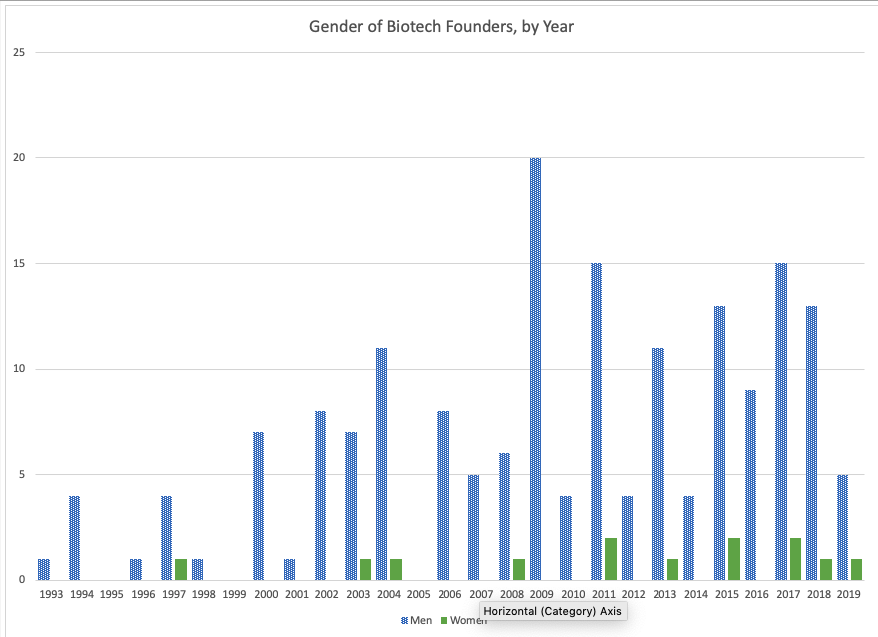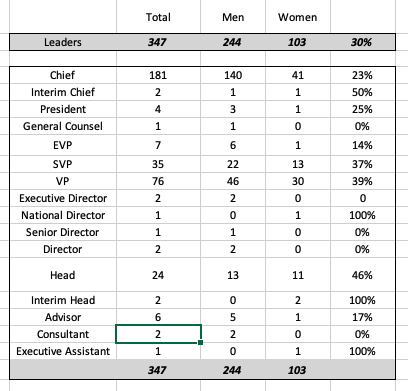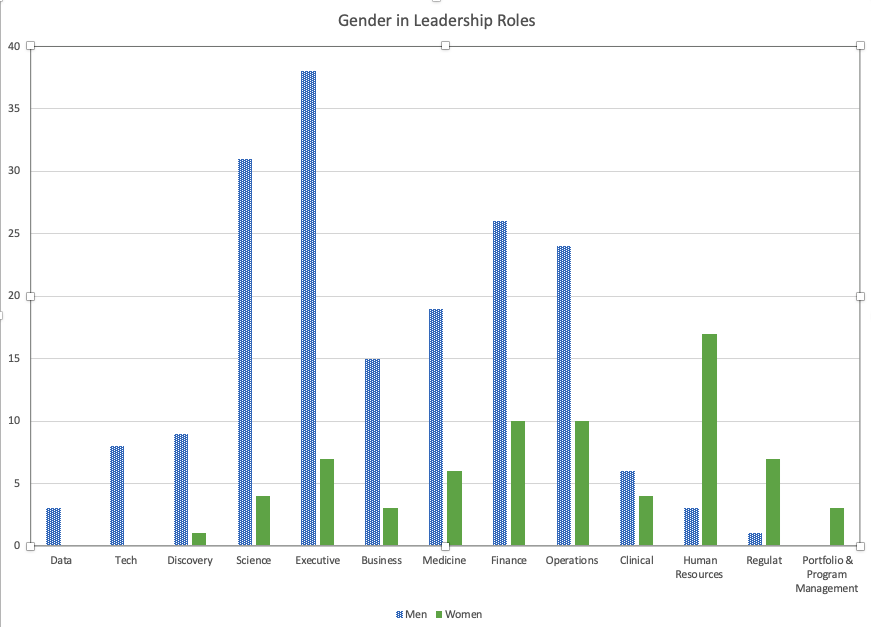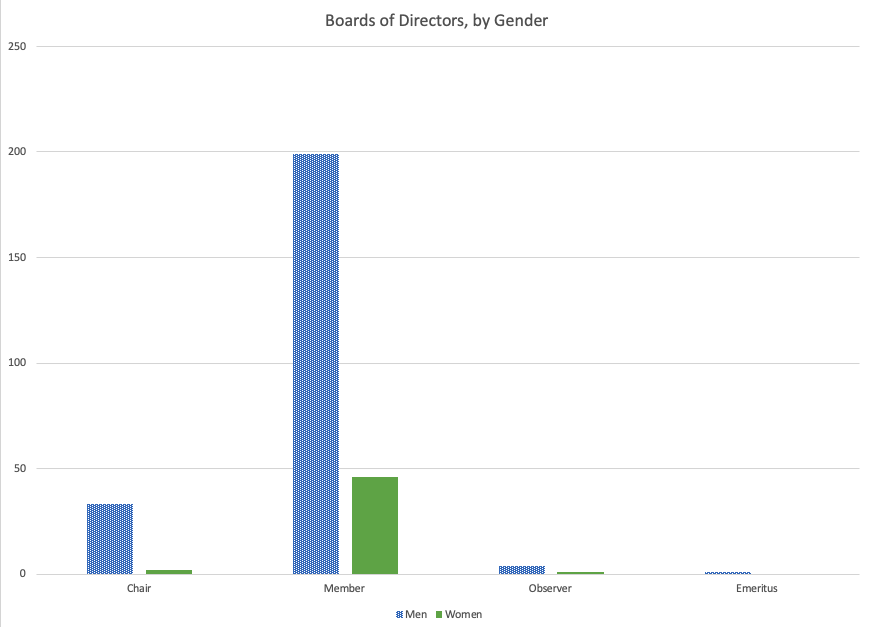On a whim the other day, I scraped the “portfolio” page on the websites of three of the large venture capital firms in Kendall Square (Atlas Venture, Flagship Pioneering, and Third Rock Ventures) to generate a list of 162 biotech companies.
The first thing I noticed was that the company names seem, disproportionately, to start with the letter ‘A.’ If company names were distributed like English words, the most common starting letter would be ‘T’. Instead, for whatever reason, we see a skew towards A, C, and S.

If we wanted to, we could come up with some sort of an explanation for this phenomenon. My personal bet is that there is a benefit to being at the top of the stack in competitive evaluations for funding. A famous study of Israeli parole boards tracked judges becoming steadily less merciful as they got hungry and tired. I’m willing to bet that venture capitalists exhibit similar behavior. If that’s true, and if people (like me) tend to sort things alphabetically, then we would expect the list to be enriched for the likes of Acceleron, Afferent, Agios, and Annovation.

Conversations about bias in the workplace can be stressful. Even bringing up the subject can feel like an accusation and incite a rush to judgement. We get so caught up in what it means and what we should do, that we lose sight of what is actually there. The rest of this post explores gender ratios in biotech leadership. I encourage you to relax away from judgement for a moment and merely consider the numbers as a sort of intellectual curiosity – as if we were talking about lexical anomalies .
Founder Effects
I went through the list in alphabetical order, looking up the people who got credit for “founding” each company. It turns out that “founder” is not terribly well defined. I included all of:
- Whoever Crunchbase said was the founder – these turn out to mostly be people from the venture firms
- Everybody mentioned as a founder on the company website
- Anybody who got a mention as a “Founding Whatever” in launch announcements in industry news sources like Fierce Biotech, or Xconomy.
Then I added a column and tagged each person according to a guess at their gender. I took gendered names and pronouns (he / her) at face value. In cases where I had any doubt, I dug around on the web until I found a bio that used a gendered pronoun. I didn’t find even one person with nonbinary pronouns or presentation in their professional persona.
With a couple days work, I got through the first 67 companies (all the way to “Fulcrum”). In those companies, I found 190 people listed as founders: 177 men and 13 women (7%).
Remember, no judgement, no explanations. We’re just counting. In this case, we’re double counting. We have some incredibly prolific founders, like Noubar Afeyan of Flagship Pioneering who shows up in 9 of these 67 companies.
The plot below spreads out those gender numbers by year. It suffers a bit from the small sample size, but – if I squint my eyes – I can begin to imagine a couple of trends.

Leadership
Out of my list of 67 companies, 47 of them are still doing business under their original name (including 24 IPOs). I went to their websites and scraped the names and titles out of the pages dedicated to the leadership teams, the boards of director, and the scientific advisors.
I took some liberties with the titles. Even though Nick Leschly of Bluebird Bio is listed as “Chief Bluebird,” I still lumped him in with the CEOs. For people with multiple titles, I selected the highest ranking one. I also exercised a bit of judgement and combined different versions of what seem objectively to be the same role (Biology vs. Biological Sciences, for example). I counted 16 distinct ranks (chief through assistant) and 78 distinct areas (science, law, HR, and so on).
Out of 347 people listed on the “leadership” pages, 244 are men and 103 are women (30%).

Gender distribution varies widely with area of responsibility. I didn’t find any women in leadership roles for data or “tech,” nor did I find very many men leading human resources or project / portfolio teams.

The Board
Boards of Directors vary widely from company to company. Most boards are made up of representatives of the firms who have made significant investments, a senior executive or two from within the company, and a selection of industry veterans.
Out of the 286 board members in my little study, 237 of them were men and 47 were women (17%) – which is very similar to the gender representation I found among CEOs. Out of 35 “chair” positions, I found 33 men and two women (6%).

The numbers were similar for the 153 people listed on the scientific and clinical advisory boards. Out of that total, 139 were men and 14 were women (9%).
So What?
As I said at the beginning, these numbers are, by themselves, neither good nor bad. They are simply a snapshot of a tiny slice of an incredibly dynamic industry. For all that, gender representations like 7%, 9%, 17%, and even 30% do seem to beg the question, what’s going on here? This is pretty far from an unbiased selection out of the human population. Scientists are constantly generating hypotheses and ideas for how to test them – I feel that some of that intellectual rigor might be valuable here.
My plan is to continue to parse, sort, sift, and learn. I’ve got 100 more company websites to scrape, and a few more low-hanging analyses to run. I expect to generate at least a couple more blog posts from this data, which will hopefully spark some downstream conversations.
At the very least, I hope to answer the question of whether or not the women leaders are mostly hanging out in the companies towards the latter half of the alphabet.
As always, I’m deeply interested in your thoughts.
